Thirty Years' War
The Thirty Years' War was a religious war fought primarily in Central Europe between 1618 and 1648. It resulted in the deaths of over 8 million people, including 20% of the German population, making it one of the most destructive conflicts in human history.[17][14] Initially a war between the Protestant and Catholic states in the Holy Roman Empire, it gradually developed into a general European war involving most of the great powers. The war became less about religion and more of a continuation of the French–Habsburg rivalry for European political pre-eminence and a Habsburg attempt to rebuild the imperial authority in Germany.[18]
| Thirty Years' War | |||||||||
|---|---|---|---|---|---|---|---|---|---|
| Part of the European wars of religion | |||||||||
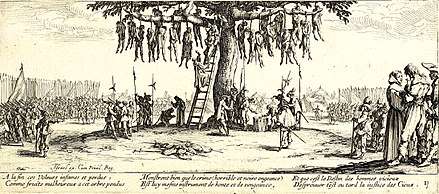 Les Grandes Misères de la guerre (The Great Miseries of the War) by Jacques Callot, 1632 | |||||||||
| |||||||||
| Belligerents | |||||||||
|
Anti-Habsburg states and allies: Supported by: |
Habsburg states and allies:
Supported by: | ||||||||
| Commanders and leaders | |||||||||
|
| ||||||||
| Strength | |||||||||
| |||||||||
| Casualties and losses | |||||||||
|
Total: 405,000–450,000 |
Total: 290,000–350,000 | ||||||||
| Total: 8,000,000 dead[16] | |||||||||
The war was instigated by the election of Ferdinand II as Holy Roman Emperor, a staunch Catholic who tried to impose religious uniformity on his domains. In response, the Protestant states of northern Germany formed the Protestant Union to defend their interests. Tensions grew until the Defenestration of Prague (1618), when Bohemian Protestants threw the Emperor's representatives out of a window. The Bohemians then elected the Protestant Frederick V, Elector Palatine, as the new king of the Kingdom of Bohemia. The Catholic states of southern Germany, led by Bavaria, formed the Catholic League to help the Emperor restore his authority in Bohemia. The Bohemian Revolt was crushed in the Battle of White Mountain (1620), and the Protestant Union dissolved in 1621. Protestant resistance was crushed at the Battle of Stadtlohn (1623), ending the Palatine phase of the Thirty Years' War.
The decisive Catholic victory would not last, as other Protestant countries entered the war to defend their brethren in Germany. Protestant Denmark intervened unsuccessfully in 1625–1630. The Protestant cause was then taken up by Gustavus Adolphus, King of Sweden, with the financial support of France. Although the Bourbon Kings of France were Catholic, their main rivals for European leadership were the Habsburg rulers of the Holy Roman Empire and Spain. Initial Swedish successes brought them deep into Catholic territory in southern Germany, but Swedish fortunes ebbed after Gustavus Adolphus was killed at the Battle of Lützen (1632). France then entered the war directly on the Protestant side in 1635. What had begun as a rebellion against Habsburg authority in Bohemia had expanded into a general European war.
The Thirty Years' War devastated entire regions, resulting in high mortality from hunger and disease. Campaigning armies and mercenaries funded themselves by looting or by exacting contributions from the inhabitants of occupied territories, imposing severe hardships on the populace. The war also bankrupted most of the combatant powers. Finally, the exhausted combatants negotiated the Peace of Westphalia (1648), putting an end to the overlapping conflicts. The rise of Bourbon France, the curtailing of Habsburg ambition, and the ascendancy of Sweden as a Great Power created a new balance of power on the continent. The Dutch Republic also secured Spanish recognition of its independence after an 80-year revolt, leading to the Dutch Golden Age.
Origins of the war
The Peace of Augsburg (1555), signed by Charles V, Holy Roman Emperor, confirmed the result of the Diet of Speyer (1526), ending the war between German Lutherans and Catholics, and establishing that:[19]
- Rulers of the 224 German states could choose the religion (Lutheranism or Catholicism) of their realms. Subjects had to follow that decision or emigrate (the principle of cuius regio, eius religio).
- Prince-bishoprics and other states ruled by Catholic clergy were excluded and should remain Catholic. Prince-bishops who converted to Lutheranism were required to give up their territories (the principle called reservatum ecclesiasticum).
- Lutherans could keep the territory they had taken from the Catholic Church since the Peace of Passau in 1552.
Although the Peace of Augsburg created a temporary end to hostilities, it did not resolve the underlying religious conflict, which was made yet more complex by the spread of Calvinism throughout Germany in the years that followed.[20] This added a third major faith to the region, but its position was not recognized in any way by the Augsburg terms, to which only Catholicism and Lutheranism were parties.[21][22]
The rulers of the nations neighboring the Holy Roman Empire also contributed to the outbreak of the Thirty Years' War:
- Spain was interested in the German states because it held the territories of the Spanish Netherlands in the western part of the Empire and states within Italy that were connected by land through the Spanish Road. The Dutch revolted against Spanish domination during the 1560s, leading to a protracted war of independence that led to a truce only in 1609.
- France was nearly surrounded by territory controlled by the two Habsburg states—Spain and the Holy Roman Empire—and, feeling threatened, was eager to exert its power against the weaker German states. This dynastic concern overtook religious ones and led to Catholic France's participation on the otherwise Protestant side of the war.
- Sweden and Denmark-Norway were interested in gaining control over northern German states bordering the Baltic Sea.
_-_DE.svg.png)
Habsburg-controlled domains:
Austrian line
Spanish line
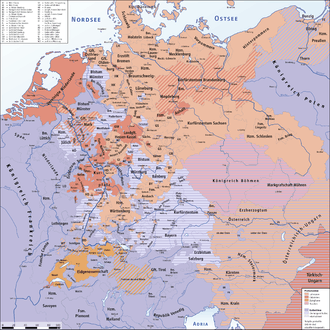
The Holy Roman Empire was a fragmented collection of largely independent states (a fragmentation that the Peace of Westphalia would solidify). The position of the Holy Roman Emperor was mainly titular, but the emperors, from the House of Habsburg, also directly ruled a large portion of imperial territory (lands of the Archduchy of Austria and the Kingdom of Bohemia), as well as the Kingdom of Hungary. The Austrian domain was thus a major European power in its own right, ruling over some eight million subjects. Another branch of the House of Habsburg ruled over Spain and its empire, which included the Spanish Netherlands, southern Italy, the Philippines, and most of the Americas. In addition to Habsburg lands, the Holy Roman Empire contained several regional powers, such as the Duchy of Bavaria, the Electorate of Saxony, the Margraviate of Brandenburg, the Electorate of the Palatinate and the Landgraviate of Hesse. A vast number of minor independent duchies, free cities, abbeys, prince-bishoprics, and petty lordships (whose authority sometimes extended to no more than a single village) rounded out the empire. Apart from Austria and perhaps Bavaria, none of those entities was capable of national-level politics; alliances between family-related states were common, due partly to the frequent practice of partible inheritance, i.e. splitting a lord's inheritance among his various sons.
Religious tensions remained strong throughout the second half of the 16th century. The Peace of Augsburg began to unravel: some converted bishops refused to give up their bishoprics, and certain Habsburg and other Catholic rulers of the Holy Roman Empire and Spain sought to restore the power of Catholicism in the region. This was evident from the Cologne War (1583–88), a conflict initiated when the prince-archbishop of the city, Gebhard Truchsess von Waldburg, converted to Calvinism. As he was an imperial elector, this could have produced a Protestant majority in the College that elected the Holy Roman Emperor, a position that was always held by a Roman Catholic.
In the Cologne War, Spanish troops expelled the former prince-archbishop and replaced him with Ernst of Bavaria, a Roman Catholic. After this success, the Catholics regained peace, and the principle of cuius regio, eius religio began to be exerted more strictly in Bavaria, Würzburg, and other states. This forced Lutheran residents to choose between conversion or exile. Lutherans also witnessed the defection of the lords of the Palatinate (1560), Nassau (1578), Hesse-Kassel (1603), and Brandenburg (1613) to the new Calvinist faith. Thus, at the beginning of the 17th century, the Rhine lands and those south to the Danube were largely Catholic, while Lutherans predominated in the north, and Calvinists dominated in certain other areas, such as west-central Germany, Switzerland, and the Netherlands. Minorities of each creed existed almost everywhere, however. In some lordships and cities, the numbers of Calvinists, Catholics, and Lutherans were approximately equal.
Much to the consternation of their Spanish ruling cousins, the Habsburg emperors who followed Charles V (especially Ferdinand I and Maximilian II, but also Rudolf II, and his successor Matthias) were content to allow the princes of the empire to choose their own religious policies. These rulers avoided religious wars within the empire by allowing the different Christian faiths to spread without coercion. This angered those who sought religious uniformity.[23] Meanwhile, Sweden and Denmark-Norway, both Lutheran kingdoms, sought to assist the Protestant cause in the Empire, and wanted to gain political and economic influence there, as well.
Religious tensions broke into violence in the German free city of Donauwörth in 1606. There, the Lutheran majority barred the Catholic residents of the Swabian town from holding an annual Markus procession, which provoked a riot called the 'battle of the flags'.[24] This prompted foreign intervention by Duke Maximilian of Bavaria on behalf of the Catholics. After the violence ceased, Calvinists in Germany (who remained a minority) felt the most threatened. They banded together and formed the Protestant Union in 1608, under the leadership of the Elector Palatine Frederick IV, whose son, Frederick V, married Elizabeth Stuart, the Scottish-born daughter of King James VI of Scotland and I of England and Ireland.[25] The establishment of the league prompted the Catholics into banding together to form the Catholic League in 1609, under the leadership of Duke Maximilian.

Tensions escalated further in 1609, with the War of the Jülich Succession, which began when John William, Duke of Jülich-Cleves-Berg, the ruler of the strategically important United Duchies of Jülich-Cleves-Berg, died childless.[26] Two rival claimants vied for the duchy. The first was Duchess Anna of Prussia, daughter of Duke John William's eldest sister, Marie Eleonore of Cleves. Anna was married to John Sigismund, Elector of Brandenburg. The second was Wolfgang William, Count Palatine of Neuburg, who was the son of Duke John William's second-eldest sister, Anna of Cleves. Duchess Anna of Prussia claimed Jülich-Cleves-Berg as the heir to the senior line, while Wolfgang William, Count Palatine of Neuburg, claimed Jülich-Cleves-Berg as Duke John William's eldest male heir. Both claimants were Protestants. In 1610, to prevent war between the rival claimants, the forces of Rudolf II, Holy Roman Emperor occupied Jülich-Cleves-Berg until the Aulic Council (Reichshofrat) resolved the dispute. However, several Protestant princes feared that the emperor Rudolf II, a Catholic, intended to keep Jülich-Cleves-Berg for himself to prevent the United Duchies falling into Protestant hands.[26] Representatives of Henry IV of France and the Dutch Republic gathered forces to invade Jülich-Cleves-Berg, but these plans were cut short by the assassination of Henry IV by the Catholic fanatic François Ravaillac.[27] Hoping to gain an advantage in the dispute, Wolfgang William converted to Catholicism; John Sigismund, though, converted to Calvinism (although Anna of Prussia stayed Lutheran).[26] The dispute was settled in 1614 with the Treaty of Xanten, by which the United Duchies were dismantled: Jülich and Berg were awarded to Wolfgang William, while John Sigismund gained Cleves, Mark, and Ravensberg.[26]
The background of the Dutch Revolt also has close relations to the events leading to the Thirty Years' War. It was widely known that the Twelve Years' Truce was set to expire in 1621, and throughout Europe it was recognized that at that time, Spain would attempt to reconquer the Dutch Republic. Forces under Ambrogio Spinola, 1st Marquis of the Balbases, the Genoese commander of the Spanish army, would be able to pass through friendly territories to reach the Dutch Republic. The only hostile state that stood in his way was the Electorate of the Palatinate.[28] Spinola's preferred route would take him through the Republic of Genoa, the Duchy of Milan, the Val Telline, around hostile Switzerland bypassing it along the north shore of Lake Constance, then through Alsace, the Archbishopric of Strasbourg, the Electorate of the Palatinate, and then finally through the Archbishopric of Trier, Jülich and Berg, and on to the Dutch Republic.[28] The Palatinate thus assumed a strategic importance in European affairs out of all proportion to its size. This explains why the Protestant James VI and I arranged for the marriage of his daughter Elizabeth Stuart to Frederick V, Elector Palatine in 1612, in spite of the social convention that a princess would only marry another royal.
By 1617, it was apparent that Matthias, Holy Roman Emperor and King of Bohemia, would die without an heir, with his lands going to his nearest male relative, his cousin Archduke Ferdinand II of Austria, heir-apparent and Crown Prince of Bohemia. With the Oñate treaty, Philip III of Spain agreed to this succession.
Ferdinand, educated by the Jesuits, was a staunch Catholic who wanted to impose religious uniformity on his lands. This made him highly unpopular in Protestant (primarily Hussite) Bohemia. The Bohemian nobility rejected Ferdinand, who had been elected Bohemian Crown Prince in 1617. Ferdinand's representatives were thrown out of a window in Prague and seriously injured, triggering the Thirty Years' War in 1618. This so-called Defenestration of Prague provoked open revolt in Bohemia, which had powerful foreign allies. Ferdinand was upset by the calculated insult, but his intolerant policies in his own lands had left him in a weak position. The Habsburg cause in the next few years would seem to suffer unrecoverable reverses. The Protestant cause seemed to wax toward a quick overall victory.
The war can be divided into four major phases: The Bohemian Revolt, the Danish intervention, the Swedish intervention, and the French intervention.
Beginnings (1618–1625)
Bohemian Revolt

Without heirs, Emperor Matthias sought to assure an orderly transition during his lifetime by having his dynastic heir (the fiercely Catholic Ferdinand of Styria, later Ferdinand II, Holy Roman Emperor) elected to the separate royal thrones of Bohemia and Hungary.[29] Some of the Protestant leaders of Bohemia feared they would be losing the religious rights granted to them by Emperor Rudolf II in his Letter of Majesty (1609). They preferred the Protestant Frederick V, elector of the Palatinate (successor of Frederick IV, the creator of the Protestant Union).[30] However, other Protestants supported the stance taken by the Catholics,[31] and in 1617, Ferdinand was duly elected by the Bohemian Estates to become the crown prince, and automatically upon the death of Matthias, the next king of Bohemia.
The king-elect then sent two Catholic councillors (Vilem Slavata of Chlum and Jaroslav Borzita of Martinice) as his representatives to Prague Castle in Prague in May 1618. Ferdinand had wanted them to administer the government in his absence. On 23 May, an assembly of Protestants seized them and threw them (and also secretary Philip Fabricius) out of the palace window, which was some 21 m (69 ft) off the ground. Although injured, they survived. This event, known as the Third Defenestration of Prague, started the Bohemian Revolt. Soon afterward, the Bohemian conflict spread through all of the Bohemian Crown, including Bohemia, Silesia, Upper and Lower Lusatia, and Moravia. Moravia was already embroiled in a conflict between Catholics and Protestants. The religious conflict eventually spread across the whole continent of Europe and also increased the concerns of a Habsburg hegemony, involving France, Sweden, and a number of other countries.[30]
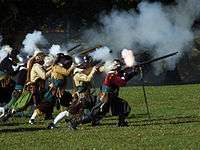
The death of Emperor Matthias emboldened the rebellious Protestant leaders, who had been on the verge of a settlement. The weaknesses of both Ferdinand (now officially on the throne after the death of Emperor Matthias) and of the Bohemians themselves led to the spread of the war to western Germany. Ferdinand was compelled to call on his nephew, King Philip IV of Spain, for assistance.
The Bohemians, desperate for allies against the emperor, applied to be admitted into the Protestant Union, which was led by their original candidate for the Bohemian throne, the Calvinist Frederick V, Elector Palatine. The Bohemians hinted Frederick would become King of Bohemia if he allowed them to join the Union and come under its protection. However, similar offers were made by other members of the Bohemian Estates to the Duke of Savoy, the Elector of Saxony, and the Prince of Transylvania. The Austrians, who seemed to have intercepted every letter leaving Prague, made these duplicities public.[32] This unraveled much of the support for the Bohemians, particularly in the court of Saxony. In spite of these issues surrounding their support, the rebellion initially favoured the Bohemians. They were joined in the revolt by much of Upper Austria, whose nobility was then chiefly Lutheran and Calvinist. Lower Austria revolted soon after, and in 1619, Count Thurn led an army to the walls of Vienna itself. Moreover, within the British Isles, Frederick V's cause became seen as that of Elizabeth Stuart, described by her supporters as "The Jewell of Europe",[33] leading to a stream of tens of thousands of volunteers to her cause throughout the course of the Thirty Years' War. In the opening phase, an Anglo-Dutch regiment under Horace Vere headed to the Palatinate, a Scots-Dutch regiment under Colonel John Seton moved into Bohemia, and that was joined by a mixed "Regiment of Brittanes" (Scots and English) led by the Scottish Catholic Sir Andrew Gray.[34] Seton's regiment was the last of the Protestant allies to leave the Bohemian theatre after tenaciously holding the town of Třeboň until 1622, and only departing once the rights of the citizens had been secured.[34]
Ottoman support for Transylvania

In the east, the Protestant Hungarian Prince of Transylvania, Gabriel Bethlen, led a spirited campaign into Hungary with the support of the Ottoman Sultan, Osman II. Fearful of the Catholic policies of Ferdinand II, Gabriel Bethlen requested a protectorate by Osman II, so "the Ottoman Empire became the one and only ally of great-power status which the rebellious Bohemian states could muster after they had shaken off Habsburg rule and had elected Frederick V as a Protestant king".[35] Ambassadors were exchanged, with Heinrich Bitter visiting Constantinople in January 1620, and Mehmed Aga visiting Prague in July. The Ottomans offered a force of 60,000 cavalry to Frederick and plans were made for an invasion of Poland with 400,000 troops, in exchange for the payment of an annual tribute to the sultan.[36] These negotiations triggered the Polish–Ottoman War of 1620–21.[37] The Ottomans defeated the Poles, who were supporting the Habsburgs in the Thirty Years' War, at the Battle of Cecora in September–October,[38] but were not able to further intervene efficiently before the Bohemian defeat at the Battle of the White Mountain in November.[39] Later, Poles defeated the Ottomans at the Battle of Chocim and the war ended with a status quo.[40]
The emperor, who had been preoccupied with the Uskok War against Venice, hurried to muster an army to stop the Bohemians and their allies from overwhelming his country. Count Bucquoy, the commander of the Imperial army, defeated the forces of the Protestant Union led by Count Mansfeld at the Battle of Sablat, on 10 June 1619. This cut off Count Thurn's communications with Prague, and he was forced to abandon his siege of Vienna. The Battle of Sablat also cost the Protestants an important ally – Savoy, long an opponent of Habsburg expansion. Savoy had already sent considerable sums of money to the Protestants and even troops to garrison fortresses in the Rhineland. The capture of Mansfeld's field chancery revealed the Savoyards' involvement, and they were forced to bow out of the war.
Catholic intervention

The Spanish sent an army from Brussels under Ambrogio Spinola to support the Emperor. In addition, the Spanish ambassador to Vienna, Don Íñigo Vélez de Oñate, persuaded Protestant Saxony to intervene against Bohemia in exchange for control over Lusatia. The Saxons invaded, and the Spanish army in the west prevented the Protestant Union's forces from assisting. Oñate conspired to transfer the electoral title from the Palatinate to the Duke of Bavaria in exchange for his support and that of the Catholic League.
The Catholic League's army pacified Upper Austria, while Imperial forces under Johan Tzerclaes, Count of Tilly, pacified Lower Austria. The two armies united and moved north into Bohemia. Ferdinand II decisively defeated Frederick V at the Battle of White Mountain, near Prague, on 8 November 1620. In addition to becoming Catholic, Bohemia remained in Habsburg hands for nearly 300 years.
This defeat led to the dissolution of the Protestant Union and the loss of Frederick V's holdings despite the tenacious defence of Trebon, Bohemia (under Colonel Seton) until 1622 and Frankenthal (under Colonel Vere) the following year.[34] Frederick was outlawed from the Holy Roman Empire, and his territories, the Rhenish Palatinate, were given to Catholic nobles. His title of elector of the Palatinate was given to his distant cousin, Duke Maximilian of Bavaria. Frederick, now landless, made himself a prominent exile abroad and tried to curry support for his cause in Sweden, the Netherlands, and Denmark-Norway.
This was a serious blow to Protestant ambitions in the region. As the rebellion collapsed, the widespread confiscation of property and suppression of the Bohemian nobility ensured that Bohemia would return to the Catholic side after more than two centuries of Hussite and other religious dissent. Seeking to outflank the Dutch in preparation for renewal of the Eighty Years' War, the Spanish seized the Electorate of the Palatinate, Frederick's lands. The first phase of the war in eastern Germany ended 31 December 1621, when the prince of Transylvania and the emperor signed the Peace of Nikolsburg, which gave Transylvania a number of territories in Royal Hungary.
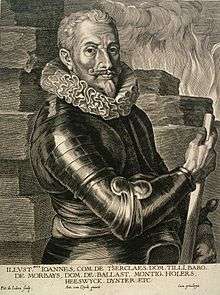
Some historians regard the period from 1621 to 1625 as a distinct portion of the Thirty Years' War, calling it the "Palatinate phase". With the catastrophic defeat of the Protestant army at White Mountain and the departure of the prince of Transylvania, greater Bohemia was pacified. However, the war in the Palatinate continued: Famous mercenary leaders – such as, particularly, Count Ernst von Mansfeld[41] – helped Frederick V to defend his countries, the Upper and the Rhine Palatinate. This phase of the war consisted of much smaller battles, mostly sieges conducted by the Imperial and the Spanish armies. Mannheim and Heidelberg fell in 1622, and Frankenthal was finally transferred two years later, thus leaving the Palatinate in the hands of the Spaniards.
The remnants of the Protestant armies, led by Mansfeld and Duke Christian of Brunswick, withdrew into Dutch service. Although their arrival in the Netherlands did help to lift the siege of Bergen-op-Zoom (October 1622), the Dutch could not provide permanent shelter for them. They were paid off and sent to occupy neighboring East Frisia. Mansfeld remained in the Dutch Republic, but Christian wandered off to "assist" his kin in the Lower Saxon Circle, attracting the attentions of Count Tilly. With the news that Mansfeld would not be supporting him, Christian's army began a steady retreat toward the safety of the Dutch border. On 6 August 1623, 16 kilometres (10 miles) short of the border, Tilly's more disciplined army caught up with them. In the ensuing Battle of Stadtlohn, Christian was decisively defeated, losing over four-fifths of his army, which had been some 15,000 strong. After this catastrophe, Frederick V, already in exile in The Hague and under growing pressure from his father-in-law, James I, to end his involvement in the war, was forced to abandon any hope of launching further campaigns. The Protestant rebellion had been crushed.
Huguenot rebellions
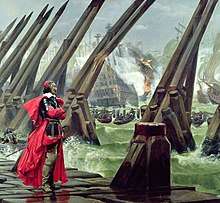
Following the Wars of Religion of 1562–1598, the Protestant Huguenots of France (mainly located in the southwestern provinces) had enjoyed two decades of internal peace under Henry IV, who was originally a Huguenot before converting to Catholicism, and had protected Protestants through the Edict of Nantes. His successor, Louis XIII, under the regency of his Italian Catholic mother, Marie de' Medici, was much less tolerant. The Huguenots responded to increasing persecution by arming themselves, forming independent political and military structures, establishing diplomatic contacts with foreign powers, and finally, openly revolting against the central power. The revolt became an international conflict with the involvement of England in the Anglo-French War (1627–29). The House of Stuart in England had been involved in attempts to secure peace in Europe (through the Spanish Match), and had intervened in the war against both Spain and France. However, defeat by the French (which indirectly led to the assassination of the English leader the Duke of Buckingham), lack of funds for war, and internal conflict between Charles I and his Parliament led to a redirection of English involvement in European affairs – much to the dismay of Protestant forces on the continent. This involved a continued reliance on the Anglo-Dutch brigade as the main agency of English military participation against the Habsburgs, although regiments also fought for Sweden thereafter.[42] France remained the largest Catholic kingdom unaligned with the Habsburg powers, and would later actively wage war against Spain. The French Crown's response to the Huguenot rebellion was not so much a representation of the typical religious polarization of the Thirty Years' War, but rather an attempt at achieving national hegemony by an absolutist monarchy.
Danish intervention (1625–1630)

Peace following the Imperial victory at Stadtlohn (1623) proved short-lived, with conflict resuming at the initiation of Denmark–Norway. Danish involvement, referred to as the Low Saxon War or Kejserkrigen ("the Emperor's War"),[43] began when Christian IV of Denmark, a Lutheran who also ruled as Duke of Holstein, a duchy within the Holy Roman Empire, helped the Lutheran rulers of the neighbouring principalities in what is now Lower Saxony by leading an army against the Imperial forces in 1625.[44] Denmark-Norway had feared that the recent Catholic successes threatened its sovereignty as a Protestant nation. Christian IV had also profited greatly from his policies in northern Germany. For instance, in 1621, Hamburg had been forced to accept Danish sovereignty.
Denmark-Norway's King Christian IV had obtained for his kingdom a level of stability and wealth that was virtually unmatched elsewhere in Europe.[45] Denmark-Norway was funded by tolls on the Øresund and also by extensive war reparations from Sweden.[46] Denmark-Norway's cause was aided by France, which together with Charles I, had agreed to help subsidize the war, not the least because Christian was a blood uncle to both the Stuart king and his sister Elizabeth of Bohemia through their mother, Anne of Denmark. Some 13,700 Scottish soldiers were sent as allies to help Christian IV under the command of General Robert Maxwell, 1st Earl of Nithsdale.[47] Moreover, some 6,000 English troops under Charles Morgan also eventually arrived to bolster the defence of Denmark-Norway, though it took longer for these to arrive than Christian hoped, not the least due to the ongoing British campaigns against France and Spain. Thus, Christian, as war-leader of the Lower Saxon Circle, entered the war with an army of only 20,000 mercenaries, some of his allies from England and Scotland and a national army 15,000 strong, leading them as Duke of Holstein rather than as King of Denmark-Norway.
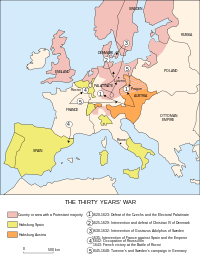
To fight Christian, Ferdinand II employed the military help of Albrecht von Wallenstein, a Bohemian nobleman who had made himself rich from the confiscated estates of his Protestant countrymen.[48] Wallenstein pledged his army, which numbered between 30,000 and 100,000 soldiers, to Ferdinand II in return for the right to plunder the captured territories. Christian, who knew nothing of Wallenstein's forces when he invaded, was forced to retire before the combined forces of Wallenstein and Tilly. Christian's mishaps continued when all of the allies he thought he had were forced aside: France was in the midst of a civil war, Sweden was at war with the Polish–Lithuanian Commonwealth, and neither Brandenburg nor Saxony was interested in changes to the tenuous peace in eastern Germany. Moreover, neither of the substantial English and Scottish contingents arrived in time to prevent Wallenstein defeating Mansfeld's army at the Battle of Dessau Bridge (1626) or Tilly's victory at the Battle of Lutter (1626).[49] Mansfeld died some months later of illness, apparently tuberculosis, in Bosnia.
Wallenstein's army marched north, occupying Mecklenburg, Pomerania, and Jutland itself, but proved unable to take the Dano-Norwegian capital Copenhagen on the island of Zealand. Wallenstein lacked a fleet, and neither the Hanseatic ports nor the Poles would allow the building of an imperial fleet on the Baltic coast. He then laid siege to Stralsund, the only belligerent Baltic port with sufficient facilities to build a large fleet; it soon became clear, however, that the cost of continuing the war would far outweigh any gains from conquering the rest of Denmark.[50] Wallenstein feared losing his northern German gains to a Danish-Swedish alliance, while Christian IV had suffered another defeat in the Battle of Wolgast (1628); both were ready to negotiate.[51]
Negotiations concluded with the Treaty of Lübeck in 1629, which stated that Christian IV could retain control over Denmark-Norway (including the duchies of Sleswick and Holstein) if he would abandon his support for the Protestant German states. Thus, in the following two years, the Catholic powers subjugated more land. At this point, the Catholic League persuaded Ferdinand II to take back the Lutheran holdings that were, according to the Peace of Augsburg, rightfully the possession of the Catholic Church. Enumerated in the Edict of Restitution (1629), these possessions included two archbishoprics, 16 bishoprics, and hundreds of monasteries. In the same year, Gabriel Bethlen, the Calvinist prince of Transylvania, died. Only the port of Stralsund continued to hold out against Wallenstein and the emperor, having been bolstered by Scottish 'volunteers' who arrived from the Swedish army to support their countrymen already there in the service of Denmark-Norway. These men were led by Colonel Alexander Leslie, who became governor of the city.[52] As Colonel Robert Monro recorded:
Sir Alexander Leslie being made Governour, he resolved for the credit of his Country-men, to make an out-fall upon the Enemy, and desirous to conferre the credit on his own Nation alone, being his first Essay in that Citie.[53]
Leslie held Stralsund until 1630, using the port as a base to capture the surrounding towns and ports to provide a secure beach-head for a full-scale Swedish landing under Gustavus Adolphus.
Mantuan Succession (1628–1631)

The War of the Mantuan Succession (1628–31) was a peripheral part of the Thirty Years' War. Its casus belli was the extinction of the direct male line of the House of Gonzaga in December 1627. Brothers Francesco IV (1612), Ferdinando (1612–26) and Vincenzo II (1626–27), the last three dukes of Mantua from the direct line, had all died leaving no legitimate heirs.
Northern Italy was a strategic battlefield for France and the Habsburgs for centuries. Control of this area allowed the Habsburgs to threaten France's restive southern provinces of Languedoc and the Dauphiné, as well as protecting the supply route known as the Spanish Road; this meant a succession dispute in Mantua inevitably involved outside parties.[3]
The Duke of Nevers was a son of Louis, younger brother of Vincenzo II's grandfather (see family tree). Louis had been naturalized French about 1550, and married the heiress of the duchies of Nevers and Rethel in 1566. For the French Crown Nevers, a French peer, would naturally be preferable as ruler in Mantua. Nevers arrived there in January 1628 and was proclaimed its sovereign.
There were two rival claimants. One was Charles Emmanuel I, Duke of Savoy, whose daughter Margaret was the widow of Francis IV. Although their son had died an infant in 1612, it was their elder daughter Maria (1612–1660) who had married Charles de Nevers in 1627. Charles Emmanuel based his right to Mantua on his daughter's claim to a substantial portion of the Gonzaga realm, the duchy of Montferrat, which was demonstrably heritable by females since the Gonzagas had acquired it through marriage to Margherita Paleologa in 1540.
The other claimant was Ferrante II, Duke of Guastalla, a distant Gonzaga cousin who voiced his claim but did not immediately place troops in the field. He was, however, supported by Emperor Ferdinand II, whose wife at the time, Eleanor of Mantua the elder (1598–1655), had been the sister of the last three Dukes of Mantua. He sought to re-attach the Duchy of Mantua to the Holy Roman Empire; Ferrante being in the Imperial-Spanish camp, was a useful tool to that purpose.
But as the Thirty Years' War wore on, it affected dynastic alliances. Charles Emmanuel obtained support from the Habsburgs, who controlled Milan.
The initial attempt of Don Gonzalo Fernandez de Córdoba, Spanish governor of Milan, and Charles-Emmanuel was to partition the Mantuan-Montferrat patrimony, which lay to east and to west of Milan. The Spanish minister supported the Guastalla claimant in Mantua, as the weaker of two neighbors, and the Savoy claimant in Montferrat, the lesser of the territories. Friction between the confederates ensued, when Charles-Emmanuel moved his troops into more territory than had been agreed upon, laying siege to the town of Casale, capital of Montferrat.
While Louis XIII of France and Cardinal Richelieu were concerned by new Huguenot uprisings in Languedoc, the capture of La Rochelle in 1628 allowed them to send forces to the relief of Casale, then besieged by a Habsburg army from Milan. In March 1629, the French stormed barricades blocking the Pas de Suse and by the end of the month they had lifted the siege of Casale and taken the strategic fortress of Pinerolo.
In April, France and Savoy agreed the Treaty of Susa and the French army returned to France, leaving a garrison at Pinerolo. The papal envoy in negotiations at Casale was Jules Mazarin. Emperor Ferdinand II's forces under Ramboldo, Count of Collalto invaded the Grisons and Valtelline. The governor was recalled from Milan,[6] followed by the insults of the citizens, for bread had been scarce for months. The following winter, Milan was devastated by the bubonic plague introduced by the armies, which has been vividly described by Manzoni.[54]
Later in 1629, Emperor Ferdinand II sent a Landsknecht army to besiege Mantua. Charles left without the promised support from Louis XIII of France. The siege lasted until July 1630, when the city, already struck by a plague, was brutally put to the sack for three days and three nights by troops led by Count Aldringen and Gallas. But the Emperor did not succeed in Mantua. Due to developments in Germany, where the Swedes were warring, he was forced to return his attention to the principal theatre of the big war.
The French first agreed to the Peace of Regensburg (or the Treaty of Ratisbonne), which was negotiated by French representatives Father Joseph and Nicolas Brûlart de Sillery. The accord was signed on 13 October 1630, which provided favorable terms to French interests in Italy despite their military setbacks. Specifically, the French were allowed to maintain their garrison in Grisons. The accord also confirmed Charles Gonzaga-Nevers as Duke of Mantua and Marquess of Montferrat in exchange for minor concessions to Charles Emmanuel of Savoy and Ferrante of Guastalla. The Habsburgs would on their side reduce their number of troops in the region. The treaty was seen as so unfavorable to the Spanish that the Spanish prime minister, Olivares, considered it no different than a surrender.
The treaty, moreover, contained a troublesome clause. It included an agreement whereby the French were not permitted to establish alliances in Germany against a reigning Holy Roman Emperor. This should have sidelined France in the ongoing conflict. Louis XIII of France refused to accept this, and the Austrians found themselves still at war, yet with diminished forces in the area. The new forces sent south of the Alps were to be sorely missed when Swedish forces under Gustavus Adolphus invaded from the north.
The Italian peace was eventually made with the Treaty of Cherasco, signed in a city in Piedmont on 19 June 1631. France, which in 1629 had taken Savoy, then captured Pinerolo in Piedmont the following year, renounced its conquests in Italy. Charles Gonzaga-Nevers was confirmed as ruler in Mantua and Montferrat, with concessions to the other claimants: Vittorio Amedeo I, who succeeded in Savoy after the sudden death of his father, Duke Charles Emmanuel, gained Trino and Alba in Montferrat; while Cesare II of Guastalla, Ferrante's son, was given Luzzara and Reggiolo. Later it was discovered that by a secret treaty with Vittorio Amedeo, Pinerolo was surrendered to France.
Swedish intervention (1630–1635)
Some in the court of Ferdinand II did not trust Wallenstein, believing he sought to join forces with the German princes and thus gain influence over the Emperor. Ferdinand II dismissed Wallenstein in 1630. He later recalled him, after the Swedes, led by King Gustavus Adolphus, had successfully invaded the Holy Roman Empire and turned the tables on the Catholics.[55][56]
Like Christian IV before him, Gustavus Adolphus came to aid the German Lutherans, to forestall Catholic suzerainty in his back yard, and to obtain economic influence in the German states around the Baltic Sea. He was also concerned about the growing power of the Habsburg monarchy, and like Christian IV before him, was heavily subsidized by Cardinal Richelieu, the chief minister of Louis XIII of France, and by the Dutch.[57] From 1630 to 1634, Swedish-led armies drove the Catholic forces back, regaining much of the lost Protestant territory. During his campaign, he managed to conquer half of the imperial kingdoms, making Sweden the leader of Protestantism in continental Europe until the Swedish Empire ended in 1721.
Swedish forces entered the Holy Roman Empire via the Duchy of Pomerania, which served as the Swedish bridgehead since the Treaty of Stettin (1630). After dismissing Wallenstein in 1630, Ferdinand II became dependent on the Catholic League. Gustavus Adolphus allied with France in the Treaty of Bärwalde (January 1631). France and Bavaria signed the secret Treaty of Fontainebleau (1631), but this was rendered irrelevant by Swedish attacks against Bavaria. At the Battle of Breitenfeld (1631), Gustavus Adolphus's forces defeated the Catholic League led by Tilly.[58][59] A year later, they met again in another Protestant victory, this time accompanied by the death of Tilly. The upper hand had now switched from the Catholic side to the Protestant side, led by Sweden. In 1630, Sweden had paid at least 2,368,022 daler for its army of 42,000 men. In 1632, it contributed only one-fifth of that (476,439 daler) towards the cost of an army more than three times as large (149,000 men). This was possible due to subsidies from France, and the recruitment of prisoners (most of them taken at the Battle of Breitenfeld) into the Swedish army.
Before that time, Sweden waged war with the Polish–Lithuanian Commonwealth and could not support the Protestant states properly. For that reason, the King Gustavus Adolphus enlisted support of the Russian Tsar Michael I, who also fought the Polish–Lithuanian Commonwealth in hopes of regaining Smolensk. While a separate conflict, the Smolensk War became an integral part of Thirty Years' confrontation.[60]
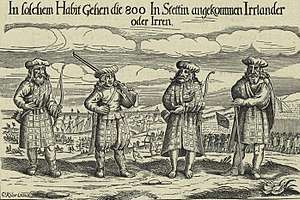
The majority of mercenaries recruited by Gustavus Adolphus were German,[61] but Scottish soldiers were also very numerous. These were composed of some 12,000 Scots already in service before the Swedes entered the war under the command of General Sir James Spens and colonels such as Sir Alexander Leslie, Sir Patrick Ruthven, and Sir John Hepburn. These were joined by a further 8,000 men under the command of James Marquis Hamilton. The total number of Scots in Swedish service by the end of the war is estimated at some 30,000 men,[62] no less than 15 of whom served with the rank of major-general or above.[63]
With Tilly dead, Ferdinand II returned to the aid of Wallenstein and his large army. Wallenstein marched up to the south, threatening Gustavus Adolphus's supply chain. Gustavus Adolphus knew that Wallenstein was waiting for the attack and was prepared but found no other option. He forced the Battle of Fürth with Wallenstein in late August 1632, arguably the greatest blunder in his German campaign.[64] The two clashed once again two months later, in the Battle of Lützen (1632), where the Swedes prevailed, but Gustavus Adolphus was killed.
Ferdinand II's suspicion of Wallenstein resumed in 1633, when Wallenstein attempted to arbitrate the differences between the Catholic and Protestant sides. Ferdinand II may have feared that Wallenstein would switch sides, and arranged for his arrest after removing him from command. One of Wallenstein's soldiers, Captain Devereux, killed him when he attempted to contact the Swedes in the town hall of Eger (Cheb) on 25 February 1634. The same year, the Protestant forces, lacking Gustavus Adolphus's leadership, were smashed at the First Battle of Nördlingen by the Spanish-Imperial forces commanded by Cardinal-Infante Ferdinand.
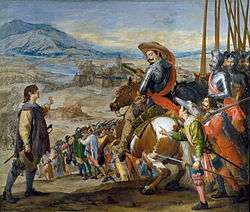
By the spring of 1635, all Swedish resistance in the south of Germany had ended. After that, the Imperial and Protestant German sides met for negotiations, producing the Peace of Prague (1635), which entailed a delay in the enforcement of the Edict of Restitution for 40 years and allowed Protestant rulers to retain secularized bishoprics held by them in 1627. This protected the Lutheran rulers of northeastern Germany, but not those of the south and west (whose lands had been occupied by the imperial or league armies prior to 1627).
The treaty also provided for the union of the army of the emperor and the armies of the German states into a single army of the Holy Roman Empire (although John George I of Saxony and Maximilian I of Bavaria kept, as a practical matter, independent command of their own forces, now nominally components of the "imperial" army). Finally, German princes were forbidden from establishing alliances amongst themselves or with foreign powers, and amnesty was granted to any ruler who had taken up arms against the emperor after the arrival of the Swedes in 1630.
This treaty failed to satisfy France, however, because of the renewed strength it granted the Habsburgs. France then entered the conflict, beginning the final period of the Thirty Years' War. Sweden did not take part in the Peace of Prague and it continued the war together with France. Initially after the Peace of Prague, the Swedish armies were pushed back by the reinforced Imperial army north into Germany.
French intervention and continued Swedish participation (1635–1648)

_-_A_landscape_with_travellers_ambushed_outside_a_small_town.jpg)
France, although mostly Roman Catholic, was a rival of the Holy Roman Empire and Spain. Cardinal Richelieu, the chief minister of King Louis XIII of France, considered the Habsburgs too powerful, since they held a number of territories on France's eastern border, including portions of the Low Countries. Richelieu had already begun intervening indirectly in the war in January 1631, when the French diplomat Hercule de Charnacé signed the Treaty of Bärwalde with Gustavus Adolphus, by which France agreed to support the Swedes with 1,000,000 livres each year in return for a Swedish promise to maintain an army in Germany against the Habsburgs. The treaty also stipulated that Sweden would not conclude a peace with the Holy Roman Emperor without first receiving France's approval.
After the Swedish rout at Nördlingen in September 1634 and the Peace of Prague in 1635, in which the Protestant German princes sued for peace with the Emperor, Sweden's ability to continue the war alone appeared doubtful, and Richelieu made the decision to enter into direct war against the Habsburgs. France declared war on Spain in May 1635 and the Holy Roman Empire in August 1636, opening offensives against the Habsburgs in Germany and the Low Countries.[65] France aligned her strategy with the allied Swedes in Wismar (1636) and Hamburg (1638).
After the Peace of Prague, the Swedes reorganised the Royal Army under Johan Banér and created a new one, the Army of the Weser under the command of Alexander Leslie. The two army groups moved south from spring 1636, re-establishing alliances on the way including a revitalised one with Wilhelm of Hesse-Kassel. The two Swedish armies combined and confronted the Imperials at the Battle of Wittstock. Despite the odds being stacked against them, the Swedish army won.[66] This success largely reversed many of the effects of their defeat at Nördlingen, albeit not without creating some tensions between Banér and Leslie.
Emperor Ferdinand II died in 1637 and was succeeded by his son Ferdinand III, who was strongly inclined toward ending the war through negotiations. His army did, however, win an important success at the Battle of Vlotho in 1638 against a combined Swedish-English-Palatine force. This victory effectively ended the involvement of the Palatinate in the war.
French military efforts met with disaster, and the Spanish counter-attacked, invading French territory. The Imperial general Johann von Werth and Spanish commander Cardinal-Infante Ferdinand of Spain ravaged the French provinces of Champagne, Burgundy, and Picardy, and even threatened Paris in 1636. Then, the tide began to turn for the French. The Spanish army was repulsed by Bernhard of Saxe-Weimar. Bernhard's victory in the Battle of Breisach pushed the Habsburg armies back from the borders of France.[67] Then, for a time, widespread fighting ensued until 1640, with neither side gaining an advantage.

In 1640 the war reached a climax and the tide turned clearly in favor of the French and against Spain, starting with the siege and capture of the fort at Arras.[68][note 9] The French conquered Arras from the Spanish following a siege that lasted from 16 June to 9 August 1640. When Arras fell, the way was opened to the French to take all of Flanders.[69] The ensuing French campaign against the Spanish forces in Flanders culminated with a decisive French victory at the battle of Rocroi in May 1643.[70]
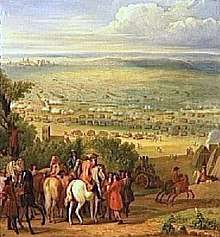
%2C_ur_%22Theatri_Europ%C3%A6i...%22_1663_-_Skoklosters_slott_-_99876.tif.jpg)
%2C_ur_%22Theatri_Europ%C3%A6i...%22_1663_-_Skoklosters_slott_-_99875.tif.jpg)
Meanwhile, an important act in the war was played out by the Swedes. After the battle of Wittstock, the Swedish army regained the initiative in the German campaign. In the Second Battle of Breitenfeld in 1642, outside Leipzig, the Swedish Field Marshal Lennart Torstenson defeated an army of the Holy Roman Empire led by Archduke Leopold Wilhelm of Austria and his deputy, Prince-General Ottavio Piccolomini, Duke of Amalfi. The imperial army suffered 20,000 casualties. In addition, the Swedish army took 5,000 prisoners and seized 46 guns, at a cost to themselves of 4,000 killed or wounded. The battle enabled Sweden to occupy Saxony and impressed on Ferdinand III the need to include Sweden, and not only France, in any peace negotiations.
Louis XIII died in 1643, leaving his five-year-old son Louis XIV on the throne. Mere days later, French General Louis II de Bourbon, 4th Prince de Condé, Duc d'Enghien, The Great Condé, defeated the Spanish army at the Battle of Rocroi in 1643. The same year, however, the French were defeated by the Imperial and Catholic League forces at the battle of Tuttlingen. The chief minister of Louis XIII, Cardinal Mazarin, facing the domestic crisis of the Fronde in 1645, began working to end the war.
In 1643, Denmark-Norway made preparations to again intervene in the war, but on the imperial side (against Sweden). The Swedish marshal Lennart Torstenson expelled Danish prince Frederick from Bremen-Verden, gaining a stronghold south of Denmark-Norway and hindering Danish participation as mediators in the peace talks in Westphalia.[71] Torstensson went on to occupy Jutland, and after the Royal Swedish Navy under Carl Gustaf Wrangel inflicted a decisive defeat on the Danish Navy in the battle of Fehmern Belt in an action of 13 October 1644, forcing them to sue for peace. With Denmark-Norway out of the war, Torstenson then pursued the Imperial army under Gallas from Jutland in Denmark south to Bohemia. At the Battle of Jankau near Prague, the Swedish army defeated the Imperial army under Gallas and could occupy Bohemian lands and threaten Prague, as well as Vienna.
In 1645, a French army under Turenne was almost destroyed by the Bavarians at the Battle of Herbsthausen. However, reinforced by Louis II de Bourbon, Prince de Condé, it defeated its opponent in the Second Battle of Nördlingen. The last Catholic commander of note, Baron Franz von Mercy, died in the battle.[72] However, the French army's effort on the Rhine had little result, in contrast to its string of victories in Flanders and Artois.[73] The same year, the Swedes entered Austria and besieged Vienna, but they could not take the city and had to retreat. The siege of Brünn in Bohemia proved fruitless, as the Swedish army met with fierce resistance from the Habsburg forces. After five months, the Swedish army, severely worn out, had to withdraw.
On 14 March 1647, Bavaria, Cologne, France, and Sweden signed the Truce of Ulm. In 1648, the Swedes (commanded by Marshal Carl Gustaf Wrangel) and the French (led by Turenne) defeated the Imperial army at the Battle of Zusmarshausen, and Condé defeated the Spanish at Lens. However, an Imperial army led by Octavio Piccolomini managed to check the Franco-Swedish army in Bavaria, though their position remained fragile. The Battle of Prague in 1648 became the last action of the Thirty Years' War. The general Hans Christoff von Königsmarck, commanding Sweden's flying column, entered the city and captured Prague Castle (where the event that triggered the war – the Defenestration of Prague – took place, 30 years before). There, they captured many valuable treasures, including the Codex Gigas, which is still today preserved in Stockholm. However, they failed to conquer the right-bank part of Prague and the old city, which resisted until the end of the war. These results left only the Imperial territories of Austria safely in Habsburg hands.
The war in the Iberian Peninsula: Spain, Catalonia, Portugal (1640–1648)
News of the French victories in Flanders in 1640 provided strong encouragement to separatist movements against Habsburg Spain in the territories of Catalonia and Portugal.[69] It had been the conscious goal of Cardinal Richelieu to promote a "war by diversion" against the Spanish[74] enhancing difficulties at home that might encourage them to withdraw from the war. To fight this war by diversion, Cardinal Richelieu had been supplying aid to the Catalans and Portuguese.[70]
The Reapers' War Catalan revolt had sprung up spontaneously in May 1640.[75] The threat of having an anti-Habsburg territory establishing a powerful base south of the Pyrenees caused an immediate reaction from the monarchy. The Habsburg government sent a large army of 26,000 men to crush the Catalan revolt. On its way to Barcelona, the Spanish army retook several cities, executing hundreds of prisoners, and a rebel army of the recently proclaimed Catalan Republic was defeated in Martorell, near Barcelona, on January, 23. In response, the rebels reinforced their efforts and the Catalan Generalitat obtained an important military victory over the Spanish army in the Battle of Montjuïc (26 January 1641) which dominated the city of Barcelona. Perpignan was taken from the Spanish after a siege of 10 months, and the whole of Roussillon fell under direct French control. The Catalan ruling powers half-heartedly accepted the proclamation of Louis XIII of France as sovereign count of Barcelona, as Lluís I of Catalonia[76] For the next decade the Catalans fought under French vassalage, taking the initiative after Montjuïc. Meanwhile, increasing French control of political and administrative affairs, in particular in Northern Catalonia, and a firm military focus on the neighbouring Spanish kingdoms of Valencia and Aragon, in line with Richelieu's war against Spain, gradually undermined Catalan enthusiasm for the French.
In parallel, in December 1640, the Portuguese rose up against Spanish rule and once again Richelieu supplied aid to the insurgents.[70] The ensuing conflict with Spain brought Portugal into the Thirty Years' War as, at least, a peripheral player. From 1641 to 1668, the period during which the two nations were at war, Spain sought to isolate Portugal militarily and diplomatically, and Portugal tried to find the resources to maintain its independence through political alliances and maintenance of its colonial income.
The war by diversion in the Iberian Peninsula had its intended effect. Philip IV of Spain was reluctantly forced to divert his attention from the war in northern Europe to deal with his problems at home.[70] Indeed, even at this time, some of Philip's advisers, including the Count of Oñate, were recommending that Philip withdraw from overseas commitments.[70] With Trier, Alsace, and Lorraine all in French hands and the Dutch in charge of Limburg, the Channel and the North Sea, the "Spanish Road" connecting Habsburg Spain with the Habsburg possessions in the Netherlands and Austria was severed. Philip IV could no longer physically send reinforcements to the Low Countries.[70] On 4 December 1642, Cardinal Richelieu died. However, his policy of war by diversion continued to pay dividends to France. Spain was unable to resist the continuing drumbeat of French victories—Gravelines was lost to the French in 1644, followed by Hulst in 1645 and Dunkirk in 1646.[70] The Thirty Years' War would continue until 1648[77] when the Peace of Westphalia was signed.
The conflict between France and Spain continued in Catalonia until 1659, with the confrontation between two sovereigns and two Catalan governments, one based in Barcelona, under the control of Spain and the other in Perpingnan, under the occupation of France. In 1652 the French authorities renounced to Catalonia's territories south of the Pyrenees, but held control of Roussillon, thereby leading to the signing of the Treaty of the Pyrenees in 1659, which finally ended the war between France and Spain, with the partition of restive Catalonia between both countries.[78] The Portuguese Restoration War ended with the Treaty of Lisbon in 1668, that terminated the 60-year Iberian Union.[79][80]
Peace of Westphalia (1648)
Over a four-year period, the warring parties (the Holy Roman Empire, France, and Sweden) were actively negotiating at Osnabrück and Münster in Westphalia.[81] The end of the war was not brought about by one treaty, but instead by a group of treaties such as the Treaty of Hamburg. On 15 May 1648, the Peace of Münster was signed, ending the Thirty Years' War. Over five months later, on 24 October, the Treaties of Münster and Osnabrück were signed.[82]
Casualties and disease
The war ranks with the worst famines and plagues as the greatest medical catastrophe in modern European history.[83][84] Lacking good census information, historians have extrapolated the experience of well-studied regions.[85] John Theibault agrees with the conclusions in Günther Franz's Der Dreissigjährige Krieg und das Deutsche Volk (1940), that population losses were great but varied regionally (ranging as high as 50%) and says his estimates are the best available.[86] The war killed soldiers and civilians directly, caused famines, destroyed livelihoods, disrupted commerce, postponed marriages and childbirth, and forced large numbers of people to relocate. The overall reduction of population in the German states was typically 25% to 40%.[87] Some regions were affected much more than others.[88] For example, Württemberg lost three-quarters of its population during the war.[89] In the region of Brandenburg, the losses had amounted to half, while in some areas, an estimated two-thirds of the population died.[90] Overall, the male population of the German states was reduced by almost half.[91] The population of the Czech lands declined by a third due to war, disease, famine, and the expulsion of Protestant population.[92][93] Much of the destruction of civilian lives and property was caused by the cruelty and greed of mercenary soldiers.[94] Villages were especially easy prey to the marauding armies. Those that survived, like the small village of Drais near Mainz, would take almost a hundred years to recover. The Swedish armies alone may have destroyed up to 2,000 castles, 18,000 villages, and 1,500 towns in Germany, one-third of all German towns.[95]
The war caused serious dislocations to both the economies and populations of central Europe, but may have done no more than seriously exacerbate changes that had begun earlier.[96][97] Also, some historians contend that the human cost of the war may actually have improved the living standards of the survivors.[98] According to Ulrich Pfister, Germany was one of the richest countries in Europe per capita in 1500, but ranked far lower in 1600. Then, it recovered during the 1600–1660 period, in part thanks to the demographic shock of the Thirty Years' War.
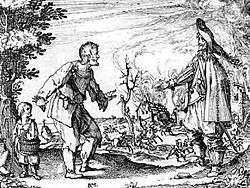
Pestilence of several kinds raged among combatants and civilians in Germany and surrounding lands from 1618 to 1648. Many features of the war spread disease. These included troop movements, the influx of soldiers from foreign countries, and the shifting locations of battle fronts. In addition, the displacement of civilian populations and the overcrowding of refugees into cities led to both disease and famine. Information about numerous epidemics is generally found in local chronicles, such as parish registers and tax records, that are often incomplete and may be exaggerated. The chronicles do show that epidemic disease was not a condition exclusive to war time, but was present in many parts of Germany for several decades prior to 1618.[99]
When the Imperial and Danish armies clashed in Saxony and Thuringia during 1625 and 1626, disease and infection in local communities increased. Local chronicles repeatedly referred to "head disease", "Hungarian disease", and a "spotted" disease identified as typhus. After the Mantuan War, between France and the Habsburgs in Italy, the northern half of the Italian peninsula was in the throes of a bubonic plague epidemic (Italian Plague of 1629–1631). During the unsuccessful siege of Nuremberg, in 1632, civilians and soldiers in both the Imperial and Swedish armies succumbed to typhus and scurvy. Two years later, as the Imperial army pursued the defeated Swedes into southwest Germany, deaths from epidemics were high along the Rhine River. Bubonic plague continued to be a factor in the war. Beginning in 1634, Dresden, Munich, and smaller German communities such as Oberammergau recorded large numbers of plague casualties. In the last decades of the war, both typhus and dysentery had become endemic in Germany.
Contemporary records recall, in harrowing detail, what life was like — people were starving in huge numbers and the Church even received reports of cannibalism.[100]
Witch hunts
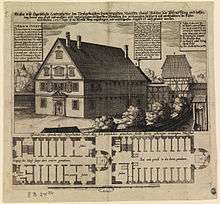
Among the other great social traumas abetted by the war was a major outbreak of witch hunting. This violent wave of inquisitions first erupted in the territories of Franconia during the time of the Danish intervention and the hardship and turmoil the conflict had produced among the general population enabled the hysteria to spread quickly to other parts of Germany. Residents of areas that had been devastated not only by the conflict but also by the numerous crop failures, famines, and epidemics that accompanied it were quick to attribute these calamities to supernatural causes. In this tumultuous and highly volatile environment allegations of witchcraft against neighbors and fellow citizens flourished.[101] The sheer volume of trials and executions during this time would mark the period as the peak of the European witch-hunting phenomenon.[102]
The persecutions began in the Bishopric of Würzburg, then under the leadership of Prince-Bishop Philipp Adolf von Ehrenberg. An ardent devotee of the Counter-Reformation, Ehrenberg was eager to consolidate Catholic political authority in the territories he administered.[103] Beginning in 1626 Ehrenberg staged numerous mass trials for witchcraft in which all levels of society (including the nobility and the clergy) found themselves targeted in a relentless series of purges. By 1630, 219 men, women, and children had been burned at the stake in the city of Würzburg itself, while an estimated 900 people are believed to have been put to death in the rural areas of the province.[102]
Concurrent with the events in Würzburg, Prince-Bishop Johann von Dornheim would embark upon a similar series of large-scale witch trials in the nearby territory of Bamberg. A specially designed Malefizhaus ('crime house') was erected containing a torture chamber, whose walls were adorned with Bible verses, in which to interrogate the accused. The Bamberg witch trials would drag on for five years and claimed upwards of 1000 lives, among them Dorothea Flock and the city's long-time Bürgermeister (mayor) Johannes Junius. Meanwhile, 274 suspected witches were put to the torch in the Bishopric of Eichstätt in 1629, while another 50 perished in the adjacent Duchy of Palatinate-Neuburg that same year.[104]
Elsewhere, the persecutions arrived in the wake of the early Imperial military successes. The witch hunts expanded into Baden following its reconquest by Tilly while the Imperial victory in the Palatinate opened the way for their eventual spread to the Rhineland.[102] The Rhenish electorates of Mainz and Trier both witnessed mass burnings of suspected witches during this time. In Cologne the territory's Prince-Elector, Ferdinand of Bavaria, presided over a particularly infamous series of witchcraft trials that included the controversial prosecution of Katharina Henot, who was burned at the stake in 1627.[102] During this time the witch hunts also continued their unchecked growth, as new and increased incidents of alleged witchcraft began surfacing in the territories of Westphalia.
The witch hunts reached their peak around the time of the Edict of Restitution in 1629 and much of the remaining institutional and popular enthusiasm for them faded in the aftermath of Sweden's entry into the war the following year. However, in Würzburg, the persecutions continued until the death of Ehrenberg in July, 1631.[102] The excesses of this period inspired the Jesuit scholar and poet Friedrich Spee (himself a former "witch confessor") to author his scathing legal and moral condemnation of the witch trials, the Cautio Criminalis. This influential work was later credited with bringing an end to the practice of witch-burning in some areas of Germany and its gradual abolition throughout Europe.[105]
Political consequences
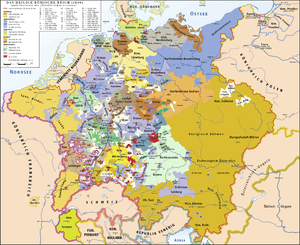
The Thirty Years' War rearranged the European power structure. During the last decade of the conflict Spain showed clear signs of weakening. While Spain was fighting in France, Portugal – which had been under personal union with Spain for 60 years – acclaimed John IV of Braganza as king in 1640, and the House of Braganza became the new dynasty of Portugal. Spain was forced to accept the independence of the Dutch Republic in 1648, ending the Eighty Years' War. Bourbon France challenged Habsburg Spain's supremacy in the Franco-Spanish War (1635–59), gaining definitive ascendancy in the War of Devolution (1667–68) and the Franco-Dutch War (1672–78), under the leadership of Louis XIV. The war resulted in the partition of Catalonia between the Spanish and French empires in the Treaty of the Pyrenees.
The war resulted in increased autonomy for the constituent states of the Holy Roman Empire, limiting the power of the emperor and decentralizing authority in German-speaking central Europe. For Austria and Bavaria, the result of the war was ambiguous. Bavaria was defeated, devastated, and occupied, but it gained some territory as a result of the treaty in 1648. Austria had utterly failed in reasserting its authority in the empire, but it had successfully suppressed Protestantism in its own dominions. Compared to large parts of Germany, much of its territory was not significantly devastated, and its army was stronger after the war than it was before, unlike that of most other states of the empire.[106] This, along with the shrewd diplomacy of Ferdinand III, allowed it to play an important role in the following decades and to regain some authority among the other German states to face the growing threats of the Ottoman Empire and France. In the longer-term, however, due to the increased autonomy of other states within the Empire, Brandenburg-Prussia was gradually able to obtain status comparable to Austria within the Empire, particularly after defeating Austria in the First Silesian War of 1740-42 enabling it to seize Silesia from Austria, and in the 19th Century Prussia would be the facilitator of the unification of the vast majority of the German peoples (aside from those in Austria and Switzerland).
From 1643 to 1645, during the last years of the war, Sweden and Denmark-Norway fought the Torstenson War. The result of that conflict and the conclusion of the Thirty Years' War helped establish postwar Sweden as a major force in Europe.
The arrangements agreed upon in the Peace of Westphalia in 1648 were instrumental in laying the legal foundations of the modern sovereign nation-state. Aside from establishing fixed territorial boundaries for many of the countries involved in the ordeal (as well as for the newer ones created afterwards), the Peace of Westphalia changed the relationship of subjects to their rulers. Previously, many people had borne overlapping, sometimes conflicting political and religious allegiances. Henceforth, the inhabitants of a given state were understood to be subject first and foremost to the laws and edicts of their respective state authority, not to the claims of any other entity, be it religious or secular. This in turn made it easier to levy national armies of significant size, loyal to their state and its leader, so as to reduce the need to employ mercenaries, whose drawbacks had been exposed a century earlier in The Prince. Among the drawbacks were the depravations (such as the Schwedentrunk) and destruction caused by mercenary soldiers, which defied description and resulted in revulsion and hatred of the sponsor of the mercenaries; there would be no other figure such as Albrecht von Wallenstein, and the age of Landsknecht mercenaries would end.
The war also had more subtle consequences. It was the last major religious war in mainland Europe, ending the large-scale religious bloodshed accompanying the Reformation, which had begun over a century before. Other religious conflicts occurred until 1712, but only on a minor scale and no great wars.[107]
Outside Europe
The war also had consequences abroad, as the European powers extended their rivalry via naval power to overseas colonies. In 1630, a Dutch fleet of 70 ships took the rich sugar-exporting areas of Pernambuco (Brazil) from the Portuguese, though the Dutch would lose them by 1654. Fighting also took place in Africa and Asia.
Phillip II and Philip III of Portugal used forts built from the destroyed temples, including Fort Fredrick in Trincomalee, and others in southern Ceylon such as Colombo and Galle Fort, to fight sea battles with the Dutch, Danish, French, and English. This was the beginning of the loss of Ceylonese sovereignty. Later the Dutch and English succeeded the Portuguese as colonial rulers of the island.[108][109]
Involvement
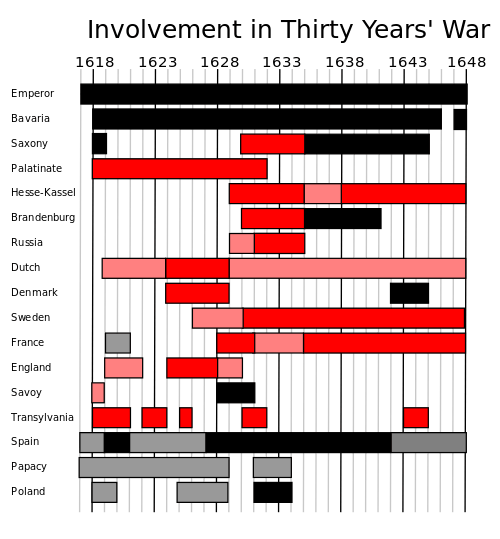
| Directly against Emperor | |
| Indirectly against Emperor | |
| Directly for Emperor | |
| Indirectly for Emperor |
In fiction
Novels
- Vida y hechos de Estebanillo González, hombre de buen humor, compuesta por él mismo (Antwerp, 1646): The last of the great Spanish Golden Age picaresque novels, this is set against the background of the Thirty Years' War. It is thought to have been written by a man in the entourage of Ottavio Piccolomini. The main character crisscrosses Europe at war in his role as messenger; he witnesses the 1634 battle of Nordlingen, among other events.
- Simplicius Simplicissimus[110] (1668) by Hans Jakob Christoffel von Grimmelshausen, one of the most important German novels of the 17th century, is the comic fictional autobiography of a half-German, half-Scottish peasant turned mercenary. He serves under various powers during the war. The book is based on the author's first-hand experience.
- Memoirs of a Cavalier (1720) by Daniel Defoe is subtitled "A Military Journal of the Wars in Germany, and the Wars in England. From the Years 1632 to 1648".
- Alessandro Manzoni's The Betrothed (1842) is an historical novel taking place in Italy in 1629. It treats a couple whose marriage is interrupted by the bubonic plague, and other complications of Thirty Years' War.
- G. A. Henty, The Lion of the North: The Adventures of a Scottish Lad during the Thirty Years' War (2 vol., 1997 reprint). It is available under a number of subtitle variants, including a comic strip. Also Won By the Sword: A Story of the Thirty Years' War
- Gertrud von Le Fort's historical novel Die Magdeburgische Hochzeit is a fictional account of romantic and political intrigue during the siege of Magdeburg.
- Der Wehrwolf (1910) by Hermann Löns is a novel about an alliance of peasants using guerrilla tactics to fight the enemy during the Thirty Years' War.
- Alfred Döblin's sprawling historical novel Wallenstein (1920) is set during the Thirty Years' War; it explores the court of Holy Roman Emperor Ferdinand.
- The Last Valley[111] (1959), by John Pick, is about two men fleeing the Thirty Years' War.
- Das Treffen in Telgte (1979), by Günter Grass, is set in the aftermath of the war. He implicitly compared conditions to those in postwar Germany in the late 1940s.
- Michael Moorcock's novel, The War Hound and the World's Pain (1981), features a central character of Ulrich von Bek, a mercenary who took part in the sack of Magdeburg.
- Eric Flint's Ring of Fire series of alternative history novels, deals with a temporally displaced American town from the early 21st century that occupies territory in the early 1630s in war-torn Germany.
- Parts of Neal Stephenson's Baroque Cycle are set in lands devastated by the Thirty Years' War.
- In The Hangman's Daughter (2008) by Oliver Pötzsch, the protagonist, hangman Jakob Kuisl, and other prominent characters have served in a General Tilly's army and participated in the sacking of the city of Magdeburg during the Thirty Years' War. "The Great War" and Swedish incursion into north-central Germany are frequently referenced.
Theatre
- Friedrich Schiller's Wallenstein trilogy (1799) is a fictional account of the downfall of this general.
- Edmond Rostand's play Cyrano de Bergerac (1897) (act IV is set during the siege of Arras in 1640.)
- Bertolt Brecht's play Mother Courage and Her Children (1939), an antiwar piece, is set during the Thirty Years' War.
Film
- Queen Christina (1933), a film starring Greta Garbo, opens with the death of Christina's father, King Gustavus Adolphus, at the Battle of Lützen in the Thirty Years' War. The plot of the film is set against the backdrop of the war and Christina's determination as queen, depicted a decade later, to end the war and bring about peace.
- A Jester's Tale (1964) is a Czech film directed by Karel Zeman. Described by Zeman as a "pseudo-historical" film, it is an anti-war black comedy set during the Thirty Years' War.
- The Last Valley (1971) is a film starring Michael Caine and Omar Sharif, who discover a temporary haven from the Thirty Years' War. it was adapted from the novel The Last Valley.
Other
- Simplicius Simplicissimus (1934–1957) is an opera adaptation of the novel of the same name, with music by Karl Amadeus Hartmann.
- The Thirty Years' War is briefly referenced in the survival horror game Amnesia: The Dark Descent. The common enemies in the game are former soldiers of the war that abandoned their duty, died and became cursed to roam the woods they died in.
Gallery
- War Scene
by Sebastian Vrancx - Battle of Sablat,
10 June 1619  Bautzen is besieged by Saxon troops, 1620 by Matthäus Merian
Bautzen is besieged by Saxon troops, 1620 by Matthäus Merian Battle of Wimpfen,
Battle of Wimpfen,
6 May 1622.jpg) Battle of Fleurus,
Battle of Fleurus,
29 August 1622 Battle of Stadtlohn,
Battle of Stadtlohn,
6 August 1623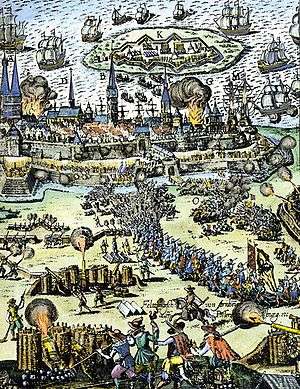 Siege of Stralsund,
Siege of Stralsund,
May to 4 August 1628 A cavalry battle
A cavalry battle
between 1626 and 1628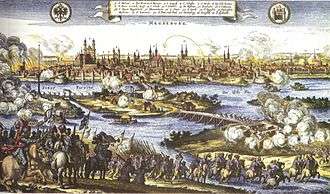
 Battle of Frankfurt an der Oder,
Battle of Frankfurt an der Oder,
April 1631_-_Nationalmuseum_-_18031.tif.jpg)
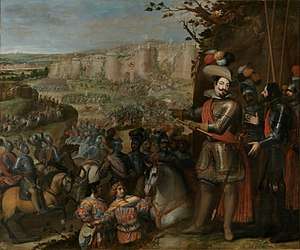
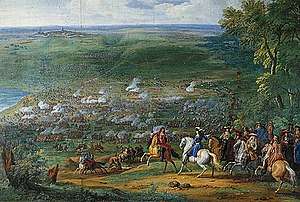 Battle of Rocroi,
Battle of Rocroi,
1643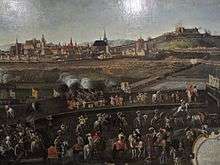 Unsuccessful Swedish-Transylvanian siege of Brno, 1645
Unsuccessful Swedish-Transylvanian siege of Brno, 1645
See also
- List of wars and disasters by death toll
- Scotland and the Thirty Years' War
- Second Thirty Years' War
- World war
- Contemporary major European conflicts:
- Eighty Years' War
- Franco-Spanish War (1635–59)
- Wars of the Three Kingdoms
Notes
- Protestantism was effectively wiped out in what is now Austria and the Czech Republic, and it was severely damaged in France, Spain, Portugal, Italy, Greece, Romania, Ireland, Belgium, Poland, Lithuania, Russia, Hungary, Ukraine, Slovakia, eastern Silesia, Slovenia, Croatia, and Serbia. Compare the territorial extent of Protestantism in 1620 and 1648.
- At war with Spain 1625–30 (and France 1627–29): 6000 Englishmen also fought under Charles Morgan in the Danish campaigns. These were largely drawn from the English brigade of four regiments which were based in the Dutch Republic.
- Scotland declared war and fought against Spain 1625–1630 and France 1627–1629, mostly conducting the war at sea. In addition to providing 2000 troops for the campaign against France in 1627, Scottish privateers harried French shipping and captured and occupied Nova Scotia, Cape Breton, and Quebec. The Scottish Privy Council also provided warrants for 13,700 troops for Danish service who fought under Scottish flag with a Dannebrog in the top left corner. These were led initially by the Catholic Robert Maxwell, Earl of Nithsdale and more famously by Donald Mackay Lord Reay. In 1630, 8000 more Britons, mostly Scots led by James 3rd Marquis Hamilton landed in Germany under British flag. They were explicitly called the "British army" and had been raised on warrants issued by the English and Scottish Privy councils for allied service alongside Sweden. They joined an estimated 12,000 Scots already in Swedish service commanded by General Sir James Spens, Alexander Leslie, Patrick Ruthven, and John Hepburn. The latter man led a Scottish brigade in France from 1634 to 1636, after which it fell under the control of the Douglas family. Throughout the entire period of the war, the Scots maintained a brigade of three regiments in Dutch service. The 1625–1638 period represents the period of greatest engagement, though Scots were active as allies in the anti-Habsburg alliance throughout the whole course of the war.
- Reconciled with the Emperor and switched sides in the Peace of Prague (1635).
- Russia supported Sweden against Poland (Smolensk War).
- Abolished in the Peace of Prague (1635). Its former members continued to support the Holy Roman Emperor.
- Swedish Intervention
- Includes soldiers from the Spanish Netherlands and Spanish Italy.
- This battle is mentioned in Edmond Rostand's play, Cyrano de Bergerac, as the battle in which Rostand's fictional character Cyrano fought.
- Of the 30,000 citizens, only 5,000 survived.
References
Citations
- The Consequences and Effects of the Thirty Years War "The later divisions that occurred made Europe more like it is now with the Catholic areas in the south and the Lutherans farther north and more importantly, it took the central power from the Catholic Church."
- Helmolt, Hans Ferdinand (1903). The World's History: Western Europe to 1800. W. Heinemann. p. 573. ISBN 978-0-217-96566-8.
- Croxton, pp. 225–26.
- Heitz p.232
- Shennan (1995), p.19
- "into line with army of Gabriel Bethlen in 1620." Ágnes Várkonyi: Age of the Reforms, Magyar Könyvklub publisher, 1999. ISBN 963-547-070-3
- Ervin Liptai: Military history of Hungary, Zrínyi Military Publisher, 1985. ISBN 9633263379
- "Victimario Histórico Militar".
- Johnson, Curt. "The French Army of the Thirty Years' War: Introduction and Maison du Roi". Xenophon Group. Early Modern Warfare Society. Retrieved 11 January 2018.
- page 54
Rennoldson, Neil. "Review Article: Spain and the Netherlands in the 17th Century" (PDF). Archived from the original (PDF) on 24 September 2015. Retrieved 7 October 2014.
When the Dutch army was increased to 77.000 in 1629 during the threatened Spanish invasion...
- "Gabriel Bethlen's army numbered 5,000 Hungarian pikemen and 1,000 German mercenary, with the anti-Habsburg Hungarian rebels numbered together approx. 35,000 men." László Markó: The Great Honors of the Hungarian State (A Magyar Állam Főméltóságai), Magyar Könyvklub 2000. ISBN 963-547-085-1
- Trueman, C. N. "Military developments in the Thirty Years War". Retrieved 16 July 2017.
- László Markó: The Great Honors of the Hungarian State (A Magyar Állam Főméltóságai), Magyar Könyvklub 2000. ISBN 963-547-085-1
- Clodfelter, Micheal (2017). Warfare and Armed Conflicts: A Statistical Encyclopedia of Casualty and Other Figures, 1492–2015. McFarland. p. 40. ISBN 978-0786474707.
- Lunsford, V. (2005). Piracy and Privateering in the Golden Age Netherlands. Springer. p. 110.
- Wilson, P. (2009). Europe's Tragedy: A History of the Thirty Years War. London: Penguin. p. 4. ISBN 978-0-7139-9592-3.
- Peter H. Wilson, Europe's Tragedy: A New History of the Thirty Years War (London: Penguin, 2010), 787.
- Roberts, J. M. (John Morris), 1928-2003 (2014). The Penguin history of the world. Westad, Odd Arne (Sixth revised ed.). London. ISBN 978-1-84614-443-1. OCLC 862761245.CS1 maint: multiple names: authors list (link)
- "Diets of Speyer (German history) – Britannica Online Encyclopedia". britannica.com. Retrieved 24 May 2008.
- Geoffrey Parker, The Thirty Years' War (Roultledge Pub.: London, 1997) pp. 17–18.
- "The Peace of Prague". historylearningsite.co.uk. Retrieved 24 May 2008.
- "Peace of Prague (1635) – Historic Event – German Archive: The Peace of Prague of 30 May 1635 was a treaty between the Holy Roman Emperor, Ferdinand II, and most of the Protestant states of the Empire. It effectively brought to an end the civil war aspect of the Thirty Years' War (1618–1648); however, the war still carried on due to the continued intervention on German soil of Spain, Sweden, and, from mid-1635, France". germannotes.com. Archived from the original on 20 October 2006. Retrieved 24 May 2008.
- Joachim., Whaley (2012). Germany and the Holy Roman Empire. Oxford: Oxford University Press. ISBN 978-0199688821. OCLC 772967090.
- Wilson, Peter. H. (2009). The Thirty Years War: Europe's Tragedy. Belknap Press of Harvard University Press.
- "Frederick the Winter King. The Columbia Encyclopedia, Sixth Edition. 2001–07". bartleby.com. Archived from the original on 16 May 2008. Retrieved 24 May 2008.
- C. V. Wedgwood, The Thirty Years' War (Penguin, 1957, 1961), p. 48.
- Pierre de l'Estoile, Journal pour le règne de Henri IV, Paris: Gallimard, p 84, 1960.
- C. V. Wedgwood, The Thirty Years' War (Penguin, 1957, 1961), p. 50.
- Edney, Steve (23 May 2006). "The Defenestration of Prague". Criticality. Retrieved 25 May 2008.
- "Bohemian Revolt". thirtyyearswar.tripod.com. Retrieved 25 May 2008.
- "Wars of the Western Civilization". visualstatistics.net. Archived from the original on 4 December 2008. Retrieved 24 May 2008.
- T. Walter Wallbank Alastair M. Taylor, Nels M. Bailkey, George F. Jewsbury, Clyde J. Lewis, Neil J. Hackett, Bruce Borland (Ed.) (1992). Civilization Past & Present Volume II. New York, N.Y: Harper Collins Publishers. pp. 15. The Development of the European State System: 1300–1650. ISBN 978-0-673-38869-8. Retrieved 23 May 2008.CS1 maint: multiple names: authors list (link) CS1 maint: extra text: authors list (link)
- Kellie, Pallas Armata, p. 2a; Monro, His Expedition, vol. 1, p. 37.
- Joseph Polisensky, "A Note on Scottish Soldiers in the Bohemian War, 1619–1622" in Steve Murdoch (ed.), Scotland and the Thirty Years' War, 1618–1648 (Brill, Leiden, 2001), pp. 111–114
- İnalcık, Halil; Faroqhi, Suraiya; Quataert, Donald; McGowan, Bruce; Pamuk, Sevket (1997). An economic and social history of the Ottoman Empire. Cambridge University Press. pp. 424–425. ISBN 978-0-521-57455-6.
- Pursell, Brennan C. (2003). The Winter King: Frederick V of the Palatinate and the Coming of the Thirty Years' War. Ashgate. pp. 112–113. ISBN 9780754634010. Retrieved 18 May 2012.
- Davies, Norman (2005). God's Playground: A History of Poland. Volume I: The Origins to 1795. Oxford University Press. ISBN 978-0-19-925339-5. Retrieved 18 May 2012.
- Shaw, Ezel Kural. History of the Ottoman Empire and Modern Turkey. p. 191. Archived from the original on 11 January 2014.
- Halil İnalcık, ed. (1994). An Economic and Social History of the Ottoman Empire. Volume 2: 1600–1914. Cambridge University Press. pp. 424–425. ISBN 978-0-521-57455-6.
- Leszek Podhorodecki: Chocim 1621, seria: Historyczne bitwy", MON, 1988.
- Concerning Mansfeld, one of the greatest military enterprisers in the early years of the war (1618–1626) see Krüssmann, Ernst von Mansfeld, (doctoral thesis, Cologne 2007) Berlin 2010.
- Adam Marks, England, the English and the Thirty Years' War, 1618–1648, PhD thesis, University of St Andrews, 2012
- Lockhart, Paul Douglas (2007). Denmark, 1513–1660: the rise and decline of a Renaissance monarchy. Oxford University Press. p. 166. ISBN 978-0-19-927121-4. Retrieved 7 August 2009.
- "Danish Kings · Christian 4". danskekonger.dk. Archived from the original on 4 April 2008. Retrieved 24 May 2008.
- Lockhart, Paul D. (2007). Denmark, 1513–1660: the rise and decline of a Renaissance monarchy. Oxford University Press. ISBN 978-0-19-927121-4.
- Wilson, Peter (2009). Europe's Tragedy. Penguin. pp. 400–433.
- Murdoch and Grosjean, pp. 43–46
- "Wallenstein Palace Gardens". prague-guide.co.uk. Archived from the original on 5 April 2008. Retrieved 24 May 2008.
- "The Danish interval". History.wisc.edu. Archived from the original on 1 January 2012. Retrieved 18 May 2012.
- "CATHOLIC ENCYCLOPEDIA: Albrecht von Wallenstein". newadvent.org. Retrieved 24 May 2008.
- Lockhart, Paul Douglas (2007). Denmark, 1513–1660: The Rise and Decline of a Renaissance Monarchy. Oxford University Press. p. 170. ISBN 978-0-19-927121-4. Retrieved 5 August 2009.
- Murdoch and Grosjean, pp. 47–51
- Monro, His Expedition, vol. 1, pp. 77–8
- Alessandro Manzoni's The Betrothed (1842) Chapter XXVII contains a lightly ironic capsule account of the War of the Mantuan Succession, as background to his narration, continued, as a further digression, in Chapter XXVIII and culminating in his famous description of the bubonic plague which the German army brought to Milan, in Chapter XXXI.
- "The Thirty-Years-War". Archived from the original on 9 October 1999.
- "Thirty Years War". hyperhistory.com. Retrieved 25 May 2008.
- "Lecture 6: Europe in the Age of Religious Wars, 1560–1715". historyguide.org. Retrieved 25 May 2008.
- "Thirty Years' War: Battle of Breitenfeld". historynet.com. 12 June 2006. Retrieved 24 May 2008.
- "History of the Thirty Years' War". historyworld.net. Retrieved 25 May 2008.
- Dukes, Paul, ed. (1995). Muscovy and Sweden in the Thirty Years' War 1630–1635. Cambridge University Press. p. . ISBN 9780521451390.
- "Soldater i trettioåriga kriget". Sfhm.se. Retrieved 18 May 2012.
- Alexia Grosjean, An Unofficial Alliance, p. 106. NB Grosjean rounds down the previous figure of 35,000 Scots believing that that number is too high as it does not separate out the English and Irish contingents
- Murdoch and Grosjean, Alexander Leslie and the Scottish Generals, passim
- Lützen 1632: Climax of the Thirty Years War; by Richard Brzezinski; 2001; Osprey Publishing; Oxford; accessed 13 January 2014; Chapter 1, "The Road to Lützen;" ISBN 1 85532 552 7.
- Thion, S. French Armies of the Thirty Years' War (Auzielle: Little Round Top Editions, 2008).
- Murdoch, S.; Zickermann, K.; Marks, A. (2012). "The Battle of Wittstock 1636: Conflicting Reports on a Swedish Victory in Germany". Northern Studies. 43: 71–109.; Murdoch and Grosjean, pp. 80–85.
- Geoffrey Parker, The Thirty Years' War (Routledge Press: London, 1984) p. 134.
- Rhea Marsh Smith, Spain: A Modern History (University of Michigan Press: Ann Arbor, Michigan, 1965), p. 195.
- Rhea Marsh Smith, Spain: A Modern History, p. 195.
- Geoffrey Parker, The Thirty Years' War, p. 153; Thion, French Armies, pp. 108, 129.
- Böhme, Klaus-R (2001). "Die sicherheitspolitische Lage Schwedens nach dem Westfälischen Frieden". In Hacker, Hans-Joachim (ed.). Der Westfälische Frieden von 1648: Wende in der Geschichte des Ostseeraums (in German). Kovač. p. 35. ISBN 978-3-8300-0500-1.
- "Franz, baron von Mercy – Britannica Online Encyclopedia". britannica.com. Retrieved 22 May 2008.
- French armies of the thirty years war, Stephane Thion
- Geoffrey Parker, The Thirty Years' War, p. 137.
- Geoffrey Parker, The Thirty Years' War (Routledge Press: London, 1984) p. 153.
- ."Catalonia, Revolt of (1640–1652) – Dictionary definition of Catalonia, Revolt of (1640–1652) | Encyclopedia.com: FREE online dictionary". www.encyclopedia.com. Retrieved 4 November 2017.
- John A. Lynn, The Wars of Louis XIV (Longman Publishers: Harlow, England, 1999) p. 11.
- John A. Lynn, The Wars of Louis XIV: 1667–1714., pp. 11–12.
- Encyclopædia Britannica. "John IV (king of Portugal)".
king of Portugal from 1640 as a result of the national revolution, or restoration, which ended 60 years of Spanish rule.
- Geoffrey Parker, The army of Flanders and the Spanish road, London, 1972 ISBN 0-521-08462-8, p. 35
- Bring, Ove (August 2000). "The Westphalian Peace Tradition in. International Law. From Jus ad Bellum to Jus contra Bellum". International Law Studies. 75: 58. Archived from the original on 22 September 2015. Retrieved 20 April 2017.
- "Germany History Timeline". countryreports.org. Archived from the original on 29 September 2008. Retrieved 24 May 2008.
- Parker, Geoffrey (2008). "Crisis and catastrophe: The global crisis of the seventeenth century reconsidered". American Historical Review. 113 (4): 1053–1079. doi:10.1086/ahr.113.4.1053.
- Outram, Quentin (2002). "The Demographic impact of early modern warfare". Social Science History. 26 (2): 245–272. doi:10.1215/01455532-26-2-245.
- Outram, Quentin (2001). "The socio-economic relations of warfare and the military mortality crises of the Thirty Years' War". Medical History. 45 (2): 151–184. doi:10.1017/S0025727300067703. PMC 1044352. PMID 11373858.
- Theibault, John (1997). "The Demography of the Thirty Years War Re-revisited: Günther Franz and his Critics". German History. 15 (1): 1–21. doi:10.1093/gh/15.1.1.
- "History of Europe – Demographics". Encyclopædia Britannica.
- Thirty Years' War: Battle of Breitenfeld, HistoryNet
- "Germany – The Thirty Years' War – The Peace of Westphalia". About.com. Retrieved 24 May 2008.
- Prussia in the later 17th century Archived 2 February 2009 at the Wayback Machine, University of Wisconsin-Madison
- Coins of the Thirty Years' War, The Wonderful World of Coins, Journal of Antiques & Collectibles January Issue 2004
- "The Thirty Years' War – Czech republic". czech.cz. Archived from the original on 4 May 2008. Retrieved 24 May 2008.
- "Historical/Cultural Timeline – 1600s". College of Education, University of Houston. Retrieved 24 May 2008.
- "The Thirty Year War and its Consequences". Universitätsstadt Tübingen. Archived from the original on 27 March 2008. Retrieved 23 May 2008.
- "Population". History Learningsite. Retrieved 24 May 2008.
- Germany after the Thirty Years' War Archived 17 February 2009 at the Wayback Machine, Boise State University
- "The Thirty Years' War". history-world.org. Retrieved 23 May 2008.
- German economic growth, 1500–1850, Pfister
- War and Pestilence, Time
- Peter H. Wilson, The Thirty Years War: A Sourcebook, Macmillan International Higher Education, 27 oct. 2010, p.270
- White, Matthew: The Great Big Book of Horrible Things W.W. Norton & co. New York, 2012 p.220
- Briggs, Robin: Witches and Neighbors: The Social and Political Context of European Witchcraft Penguin Books, New York 1996
- Gary F. Jensen (2007). The Path of the Devil: Early Modern Witch Hunts. Rowman & Littlefield. ISBN 9780742546974. Retrieved 5 August 2013.
- Hugh Trevor-Roper: The Crisis of the Seventeenth Century. The European Witch-craze of the Sixteenth and Seventeenth Centuries (1967)
- Reilly, Pamela (1959). "Friedrich von Spee's Belief in Witchcraft: Some Deductions from the "Cautio Criminalis"". The Modern Language Review. 54 (1): 51–55. doi:10.2307/3720833. JSTOR 3720833.
- Histoire de l'empire Habsbourg, Jean Bérenger
- "Lecture 6: Europe in the Age of Religious Wars, 1560–1715". historyguide.org. Retrieved 27 May 2008.
- Gnanaprakasar, S. A Critical History of Jaffna, pp. 153–72.
- "Portuguese Colonial Period (1505 CE–1645 CE)". Rohan Titus. Retrieved 7 December 2007.
- Grimmelshausen, H. J. Chr. (1669) [1668]. Der abentheurliche Simplicissimus [The adventurous Simplicissimus] (in German). Nuremberg: J. Fillion. OCLC 22567416.
- Pick, J.B. (1959). The Last Valley. Boston: Little, Brown (published 1960). OCLC 1449975.CS1 maint: ref=harv (link)
Sources
Primary sources
- Sir Thomas Kellie, Pallas Armata or Military Instructions for the Learned, The First Part (Edinburgh, 1627).
- Monro, R. His Expedition with a worthy Scots Regiment called Mac-Keyes, (2 vols., London, 1637) www.exclassics.com/monro/monroint.htm.
- Helfferich, Tryntje, ed. The Thirty Years' War: A Documentary History, (Indianapolis: Hackett, 2009). 352 pages. 38 key documents including diplomatic correspondence, letters, broadsheets, treaties, poems, and trial records. excerpt and text search
- Wilson, Peter H. ed. The Thirty Years' War: A Sourcebook (2010); includes state documents, treaties, correspondence, diaries, financial records, artwork; 240pp
- Dr Bernd Warlich has edited four diaries of the Thirty Years' War (1618–1648). These diaries can be viewed (in German) at: http://www.mdsz.thulb.uni-jena.de/sz/index.php
Further reading
- Åberg, A. (1973). "The Swedish army from Lützen to Narva". In Roberts, M. (ed.). Sweden's Age of Greatness, 1632–1718. London: St. Martin's Press.
- Asbach, Olaf, and Peter Schröder, eds. The Ashgate Research Companion to the Thirty Years' War (2014). 347pp. online review
- Benecke, Gerhard (1978). Germany in the Thirty Years War. London: St. Martin's Press.
- Bonney, Richard (2002). The Thirty Years' War 1618–1648. Osprey.; focus on combat
- Dukes, Paul, ed. (1995). Muscovy and Sweden in the Thirty Years' War 1630–1635. Cambridge University Press. ISBN 9780521451390.
- Grosjean, Alexia (2003). An Unofficial Alliance: Scotland and Sweden, 1569–1654. Leiden: Brill.
- Cramer, Kevin (2007). The Thirty Years' War & German Memory in the Nineteenth Century. Lincoln: University of Nebraska. ISBN 978-0-8032-1562-7.
- Gindely, Antonín (1884). History of the Thirty Years' War. Putnam.
- Gutmann, Myron P. (1988). "The Origins of the Thirty Years' War". Journal of Interdisciplinary History. 18 (4): 749–770. doi:10.2307/204823. JSTOR 204823.
- Kamen, Henry (1968). "The Economic and Social Consequences of the Thirty Years' War". Past and Present. 39 (39): 44–61. doi:10.1093/past/39.1.44. JSTOR 649855.
- Kennedy, Paul (1988). The Rise and Fall of the Great Powers: Economic Change and Military Conflict from 1500 to 2000. New York: Harper Collins.
- Langer, Herbert (1980). The Thirty Years' War. Poole, England: Blandford Press.
- Lynn, John A. (1999). The Wars of Louis XIV: 1667–1714. Harlow, England: Longman.
- Murdoch, Steve (2001). Scotland and the Thirty Years' War, 1618–1648. Brill.
- Murdoch, S.; Zickermann, K.; Marks, A. (2012). "The Battle of Wittstock 1636: Conflicting Reports on a Swedish Victory in Germany". Northern Studies. 43: 71–109.
- Murdoch, Steve; Alexia, Grosjean (2014). Alexander Leslie and the Scottish generals of the Thirty Years' War, 1618–1648. London: Pickering & Chatto.
- Parker, Geoffrey (1984). The Thirty Years' War. London: Routledge and Kegan Paul.
- Parrott, D (2001). Richelieu's Army: War, Government and Society in France, 1624–1642. Cambridge University Press.
- Polišenský, J. V. (1954). "The Thirty Years' War". Past and Present. 6 (6): 31–43. doi:10.1093/past/6.1.31. JSTOR 649813.
- Polišenský, J. V. (1968). "The Thirty Years' War and the Crises and Revolutions of Seventeenth-Century Europe". Past and Present. 39 (39): 34–43. doi:10.1093/past/39.1.34. JSTOR 649854.
- Polisensky, Joseph (2001). "A Note on Scottish Soldiers in the Bohemian War, 1619–1622". In Murdoch, Steve (ed.). Scotland and the Thirty Years' war, 1618–1648. Leiden: Brill. pp. 109–115.
- Prinzing, Friedrich (1916). Epidemics Resulting from Wars. Oxford: Clarendon Press.
- Rabb, Theodore K (1962). "The Effects of the Thirty Years' War on the German Economy". Journal of Modern History. 34 (1): 40–51. doi:10.1086/238995. JSTOR 1874817.
- Ringmar, Erik (2008) [1996]. Identity, Interest and Action: A Cultural Explanation of the Swedish Intervention in the Thirty Years War. Cambridge University Press. ISBN 978-0521026031.CS1 maint: ref=harv (link)
- Roberts, Michael (1958). Gustavus Adolphus: A History of Sweden, 1611–1632. Longmans, Green and C°.
- Thion, S. (2008). French Armies of the Thirty Years' War. Auzielle: Little Round Top Editions.
- Ward, A. W. (1902). The Cambridge Modern History. Volume 4: The Thirty Years War.
- Heitz, Gerhard; Rischer, Henning (1995). Geschichte in Daten. Mecklenburg-Vorpommern (in German). Münster-Berlin: Koehler&Amelang. ISBN 3-7338-0195-4.
- Wedgwood, C. V. (2005). Thirty Years War. foreword by Anthony Grafton. New York: The New York Review of Books, Inc. ISBN 978-1-59017-146-2.
- Wilson, Peter H. (2009). Europe's Tragedy: A History of the Thirty Years War. Allen Lane. ISBN 978-0-7139-9592-3.
Videos:
- "The Thirty Years' War - how was peace achieved? (history documentary)". Deutsche Welle Documentary. 1 November 2018. (Part 2)
- "The 30 Years' War (1618–48) and the Second Defenestration of Prague – Professor Peter Wilson". Gresham College. 24 May 2018.
External links
| Wikimedia Commons has media related to Thirty Years War. |
| Wikivoyage has a travel guide for Thirty Years War. |
- . Encyclopædia Britannica. 26 (11th ed.). 1911.
- Spahn, Martin (1912). . Catholic Encyclopedia. 14.
- The Thirty Years' War – Czech republic
- The Thirty Years' War LearningSite
- Thirty Years' War Timeline
- Project "Peace of Westphalia" (among others with Essay Volumes of the 26th Exhibition of the Council of Europe "1648: War and Peace in Europe", 1998/99)
- History of the Thirty Years' War by Friedrich von Schiller at Project Gutenberg
- BBC Radio4 documentary – The Invention of Germany: The Thirty Years' War and Magdeburg
- - Sovereignty, International Relations, and the Westphalian Myth